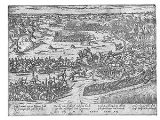
Battle of Heiligerlee
Encyclopedia
The Battle of Heiligerlee (Heiligerlee
, Groningen, 23 May 1568) was fought between Dutch
rebels and the Spanish
army of Friesland
. This was the first Dutch victory during the Eighty Years' War.
The Groningen
province
of the Spanish Netherlands was invaded by an army consisting of 3,900 infantry led by Louis of Nassau
and 200 cavalry led by Adolf of Nassau. Both were brothers of William I of Orange. The intention was to begin an armed uprising against the Spanish rulers of the Netherlands.
The Stadtholder
of Friesland and also Duke of Aremberg, Johan de Ligne
, had an army of 3,200 infantry and 20 cavalry.
Aremberg initially avoided confrontation, awaiting reinforcements. However on 23 May, Adolf's cavalry lured him to an ambush
at the monastery of Heiligerlee. Louis' infantry, making up the bulk of the army, defeated the Spanish force which lost 1,500–2,000 men, while the invading force lost 50, including Adolf. The rebels captured seven cannon
.
The invading force however, did not capture any cities and was soon defeated at the Battle of Jemmingen
.
The death of Adolf of Nassau is mentioned in the Dutch national anthem (4th verse):
Heiligerlee
Heiligerlee is a village in the Dutch province of Groningen bordering the town of Winschoten, it is part of the municipality of Oldambt. The village is known for having been the site of the first battle of the Dutch rebels against the Spanish. The army led by Louis and Adolf of Nassau defeated the...
, Groningen, 23 May 1568) was fought between Dutch
Netherlands
The Netherlands is a constituent country of the Kingdom of the Netherlands, located mainly in North-West Europe and with several islands in the Caribbean. Mainland Netherlands borders the North Sea to the north and west, Belgium to the south, and Germany to the east, and shares maritime borders...
rebels and the Spanish
Spain
Spain , officially the Kingdom of Spain languages]] under the European Charter for Regional or Minority Languages. In each of these, Spain's official name is as follows:;;;;;;), is a country and member state of the European Union located in southwestern Europe on the Iberian Peninsula...
army of Friesland
Friesland
Friesland is a province in the north of the Netherlands and part of the ancient region of Frisia.Until the end of 1996, the province bore Friesland as its official name. In 1997 this Dutch name lost its official status to the Frisian Fryslân...
. This was the first Dutch victory during the Eighty Years' War.
The Groningen
Groningen (province)
Groningen [] is the northeasternmost province of the Netherlands. In the east it borders the German state of Niedersachsen , in the south Drenthe, in the west Friesland and in the north the Wadden Sea...
province
Seventeen Provinces
The Seventeen Provinces were a personal union of states in the Low Countries in the 15th century and 16th century, roughly covering the current Netherlands, Belgium, Luxembourg, a good part of the North of France , and a small part of Western Germany.The Seventeen Provinces were originally held by...
of the Spanish Netherlands was invaded by an army consisting of 3,900 infantry led by Louis of Nassau
Louis of Nassau
Louis of Nassau was the third son of William, Count of Nassau and Juliana of Stolberg, and the younger brother of Prince William of Orange Nassau....
and 200 cavalry led by Adolf of Nassau. Both were brothers of William I of Orange. The intention was to begin an armed uprising against the Spanish rulers of the Netherlands.
The Stadtholder
Stadtholder
A Stadtholder A Stadtholder A Stadtholder (Dutch: stadhouder [], "steward" or "lieutenant", literally place holder, holding someones place, possibly a calque of German Statthalter, French lieutenant, or Middle Latin locum tenens...
of Friesland and also Duke of Aremberg, Johan de Ligne
Jean de Ligne, Duke of Aremberg
Jean de Ligne, Duke of Arenberg was Baron of Barbançon, founder of the House of Arenberg and stadtholder of the Dutch provinces of Friesland, Groningen, Drenthe and Overijssel from 1549 until his death....
, had an army of 3,200 infantry and 20 cavalry.
Aremberg initially avoided confrontation, awaiting reinforcements. However on 23 May, Adolf's cavalry lured him to an ambush
Ambush
An ambush is a long-established military tactic, in which the aggressors take advantage of concealment and the element of surprise to attack an unsuspecting enemy from concealed positions, such as among dense underbrush or behind hilltops...
at the monastery of Heiligerlee. Louis' infantry, making up the bulk of the army, defeated the Spanish force which lost 1,500–2,000 men, while the invading force lost 50, including Adolf. The rebels captured seven cannon
Cannon
A cannon is any piece of artillery that uses gunpowder or other usually explosive-based propellents to launch a projectile. Cannon vary in caliber, range, mobility, rate of fire, angle of fire, and firepower; different forms of cannon combine and balance these attributes in varying degrees,...
.
The invading force however, did not capture any cities and was soon defeated at the Battle of Jemmingen
Battle of Jemmingen
After the Battle of Heiligerlee Louis of Nassau failed to capture the city Groningen. Louis was driven away by Fernando Álvarez de Toledo, Duke of Alba and defeated at the Battle of Jemmingen on 21 July 1568.-Forces:The Spanish army consisted of 12,000 infantry , 3,000 cavalry, and some cannon...
.
The death of Adolf of Nassau is mentioned in the Dutch national anthem (4th verse):
- Graef Adolff is ghebleven, In Vriesland in den slaech,
- "Count Adolf stayed behind, in Friesland, in the battle"

